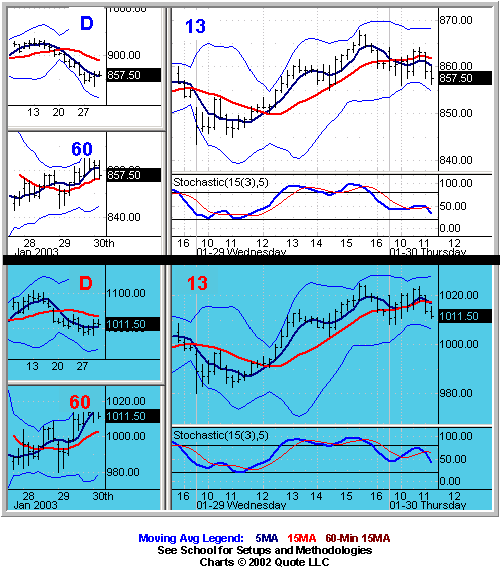This May Accelerate Your Learning Curve
The early Thursday morning
trade has been dominated by a significant battle between conflicting hourly and
13-minute trends as we head to press.
Given the daily downtrend backdrop, eyes have been strongly focused on the
strength of the hourly climb (pathetic on the early bounces as defined by a
horizontal stochastic) and whether the 13-minute downtrend would hold to result
in a break of hourly support. A break of hourly support is of course needed to
trigger a more significant continuation of the daily downtrend.
As the result of reader feedback, I thought I’d post a visual snapshot of the
morning trade sequence in my scalp account (defined as quick in/out trades using
the 1- and 3-minute time frames) for teaching purposes — information which I
share with my
mentor students similar to that which is provided in the
E-Mini videotape. As is always the case, I preface such data in such a way
to remind all that it’s shared for educational purposes only and is in no way
meant to be a “look at what Don did” exercise or view that every day goes like
this. Nor does it encourage folks to become hyperactive scalpers on the lesser
time frames as most methods can apply to any time frame. Yet I find that
occasionally sharing 1- and 3-minute examples — along with the longer-term
13-minute through daily charts in each column which don’t go stale the minute
the virtual ink is dry — can accelerate one’s learning curve since many
opportunities present themselves in a short period of time.
I’m also a strong believer in using practical examples to demonstrate methods,
and detest market “guidance” offered by those who never seem to have a losing
trade or provide sterile advice that looks so clear after the fact. Anyway, with
that said, I hope you find the chart below and accompanying legend — which tie
to broker records — helpful and would appreciate any feedback as to its
usefulness. The entries, exits, and stops all reflect our methods including
using the 15MA as trend guidance, scaling out of positions to ensure some
position(s) remain for larger moves, striving for at least 2:1 reward/risk
ratios, using stops on 15MA breaks, and taking second or third entries.
While I trade both scalp and longer-term accounts, I was admittedly a bit more
focused on scalp opportunities this morning until the 13 & 60 minute ES
conflicts resolved themselves. I also avoided longs until the 13-minute proved
itself to the north, which never occurred, although I did consider a 10:35 scalp
long when I covered the short on the 3-minute cross, yet didn’t like the
reward/risk ratio given lack of proof of a true 13-minute turn. The largest
stop in this sequence was (1.25) and the largest gain 4.00.
Again, please use this in the spirit in which it’s intended. If it helps,
great.
ES (S&P) Thursday
January 30, 2003 11:00 A.M. ET NQ
(Nasdaq)


Good Trading!
